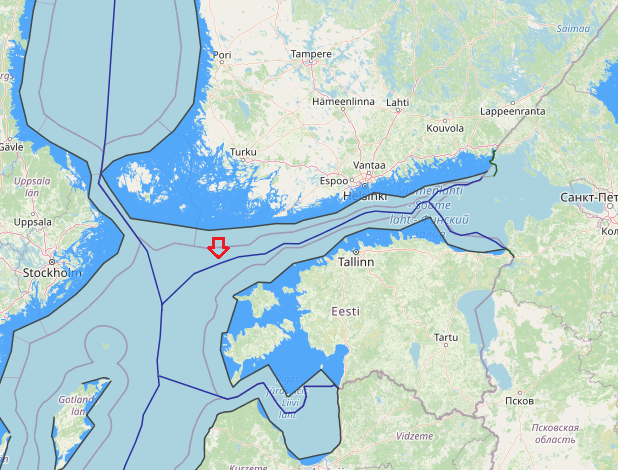Finland and Sweden, two neighboring Nordic countries known for their peaceful coexistence, have been engaged in several maritime disputes over the years. These conflicts involve overlapping claims in the Baltic Sea and the Gulf of Bothnia, and have significant strategic implications for both nations. Understanding the historical background, assessing the strategic implications, analyzing legal perspectives, and evaluating potential resolutions are crucial steps towards finding a peaceful and mutually beneficial solution.
View More Analyzing Finland and Sweden’s Maritime Disputes: Implications and ResolutionsTag: Finland
maritime boundaries between Finland and Russia
between Russia and Finland, the boundary is on the shore of Gulf of Finland, in which there is a maritime boundary between the respective territorial waters, terminating in a narrow strip of international waters between Finnish and Estonian territorial waters. In 2014, Estonia and the Russian Federation signed their land and maritime boundary agreements that are currently awaiting ratification. This study reconstructs the maritime boundary delimitation between the two States. In particular, the role of islands and pre-existing agreements for the delimitation of the territorial sea boundary in the south-eastern part of the Gulf of Finland are critically examined. It is established that the agreed maritime boundary line is a median line which was influenced by the use of the special circumstances method in the delimitation process. in relation to the first part of the Finland-USSR maritime boundary, military, strategic and related navigational considerations have had a powerful influence on the course of maritime boundaries and it had not based on equidistance method alone.
View More maritime boundaries between Finland and Russiamaritime boundaries between Finland and Estonia
Agreement between the Republic of Estonia and the Republic of Finland on the Boundary of the Maritime Zones in the Gulf of Finland and the Northern Baltic Sea was signed in 18 October 1996. In principle, the main aim of the negotiations was not to try to establish a maritime boundary in areas· where no such boundary existed before. In fact, only a very minor part of this agreement could fit such a description. What the Estonia-Finland Agreement did rather was to provide an answer to the much more subtle question about the ·exact legal value to be attributed under international law to the previously concluded maritime boundary agreements, in casu by the former Soviet Union.
View More maritime boundaries between Finland and EstoniaMaritime boundaries between Finland and Sweden
The Finland-Sweden continental shelf agreement is plotted on the attached DMA/HC charts 44030 and 44180. The official Finnish nautical charts cited in Article 6 of the Agreement were used to compute the distances between the boundary points and Finnish straight baselines. Official Swedish charts Nos. 41, 42, 51, 53, and 71 (1:200,000) were used to measure distances to the Swedish baselines.
The shelf boundary extends for a distance of approximately 419.76 nautical miles and has 17 turning or terminal points. The boundary runs the entire length of the Gulf of Bothnia, through the narrow Aland Sea, and into the northernmost part of Baltic Sea.
Finland claims about straight baselines and the median line separating the continental shelf and fishery zones of Finland from the continental shelves and exclusive economic zones of Estonia and Sweden
Finland claims about straight baselines and the median line separating the continental shelf and fishery zones of Finland from the continental shelves and exclusive economic zones of Estonia and Sweden, Estonia, Estonia maritime boundaries, Finland, Finland continental shelf map, Finland EEZ map, Finland maritime boundaries, Finland maritime claims, Finland straight baselines, Finland territorial sea map, Maritime Claims, Sweden, The Gulf of Finland
View More Finland claims about straight baselines and the median line separating the continental shelf and fishery zones of Finland from the continental shelves and exclusive economic zones of Estonia and SwedenFinland claims about straight baselines and outer limits of the territorial sea
Finland claims about straight baselines and outer limits of the territorial sea, Act on the Delimitation of the Territorial Waters of Finland, Finland, Finland continental shelf map, Finland EEZ map, Finland maritime boundaries, Finland maritime claims, Finland straight baselines, Finland territorial sea map, Maritime Claims, The Finnish straight baseline, The Finnish straight baseline around the Aland ̊ archipelago and the Swedish-Finnish territorial seas
View More Finland claims about straight baselines and outer limits of the territorial seaNavigational Regimes of Particular Straits, Aland case study
When it ratified the LOS Convention in 1996, Finland confirmed its declaration on signature in part that:
It is the understanding of the Government of Finland that the exception from the transit passage regime in straits provided for in article 35(c) of the Convention is applicable to the strait between Finland (the Åland Islands) and Sweden. Since in that strait the passage is regulated in part by a longstanding international convention in force, the present legal regime in that strait will remain unchanged after the entry into force of the Convention. Navigational Regimes of Particular Straits, Aland case study, Aland case study, Finland, Gulf of Bothnia, international straits, legal regime in that strait, Particular Straits
STATE CLAIMS IN SUBSTANTIAL CONFORMITY WITH ARTICLE 4 (LOSC ARTICLE 7), Norway, Sweden, and Finland cases
STATE CLAIMS IN SUBSTANTIAL CONFORMITY WITH ARTICLE 4 (LOSC ARTICLE 7), Norway, Sweden, and Finland cases, Finland, LOSC, Norway, Sweden
View More STATE CLAIMS IN SUBSTANTIAL CONFORMITY WITH ARTICLE 4 (LOSC ARTICLE 7), Norway, Sweden, and Finland cases






